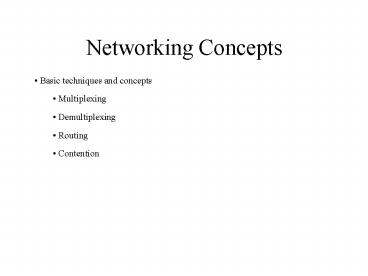Networking Concepts - PowerPoint PPT Presentation
1 / 24
Title:
Networking Concepts
Description:
So we need to be able to combine different channels to create larger bandwidths ... of the N-1 interleaved pulses can coherently beat with the pulses in the channel ... – PowerPoint PPT presentation
Number of Views:17
Avg rating:3.0/5.0
Title: Networking Concepts
1
Networking Concepts
- Basic techniques and concepts
- Multiplexing
- Demultiplexing
- Routing
- Contention
2
Multiplexing
- Most users need relatively low bandwidth
- Transmission is more economical at higher
bandwidth - So we need to be able to combine different
channels to create larger bandwidths
- We also need to be able to separate the channels
when required
3
(No Transcript)
4
TDM devices
- A simple optical coupler will achieve TDM
multiplexing - remember that the power loss depends on the
number of channels multiplexed
(Min)Insertion loss -10logN
N
5
(No Transcript)
6
Pedestal Requirement
7
Wavelength Division Multiplexing
- Individual channels consist of different
wavelengths of light - any format is possible in principle
- When combined, the channels overlap in time
- Need to ensure that the channels are far enough
apart to avoid crosstalk
8
Coarse WDM
- Originally used to refer to two wavelengths
- 1300nm and 1550nm
- Latest ITU standards allow for 20nm spacing
- Cover 1270nm to 1610
- Wide channel spacing allows for lower cost
lasers - ITU-T G.695 standard
9
Dense WDM
- Closely spaced channels
- 50GHz spaced frequencies defined
- Lasers require frequency stabilisation
- Preferred option for long haul transmission
- ITU-T G.694.2
10
WDM devices
- A wavelength dependent optical coupler will
achieve WDM multiplexing - the power loss does not necessarily depend on
the number of channels multiplexed
?1
?1,..., ?N
?N
11
WDM sources
- ITU specifications
- various grids are specified with e.g 200GHz
spacing - note spacing is constant in frequency, not
wavelength - Limitations
- stability
- linewidth
?1
?N
12
Demultiplexing
- Inverse operation to multiplexing
- Time domain, need to be able to access a single
channel - need access to some form of modulator switch
- need for channel identification
- need for clock recovery
- Wavelength domain, need to be able to filter out
a single channel - need for good bandpass filters
13
TDM devices
Detect
Clock
Modulate
- This diagram shows a typical TDM demultiplexer
- Some signal is extracted and detected
electrically - The electrical signal is used to derive a
suitable clock - The clock is used to drive a modulator
- Clock recovery
- Typically involves dividing down
- Binary cascades are common
14
(No Transcript)
15
AWG mux/demux
16
(No Transcript)
17
Sink Trees
- Optimality principle
- if route ABC is optimal from A to C then AB is
optimal and so is BC - independent of definition of optimal
- Sink Tree
- set of optimal routes to a given destination
18
(No Transcript)
19
(No Transcript)
20
Contention
- Generic network problem
- two channels at the input want to use the same
output - Bandwidth management
- Simple to solve, only consider ?free? resources
- Packet switching
- Need for memory (buffer)
- bad news for optics, no static memories exist
- use delay lines
- channel translation
21
Other techniques
- Wavelength routing
- uses wavelength as a physical address
- typically requires wavelength conversion
- Negotiated wavelength transmission
- Before transmitting a wavelength channel is
allocated - requires some form tunable source
- Amplification
- will always be required on global scale networks
- need wide-band flat gain spectrum
22
(No Transcript)
23
Wavelength Conversion
- O-E-O switch
- hybrid solution involving electronic detection
followed by re-modulation on a new wavelength - tends to lock in many properties of the system
- expensive in terms of device count
- all-optical methods
- must be optically nonlinear
- four wave mixing, cross modulation
24
Next lecture
- Switching architectures
- Blocking
- Buffering
- Add/Drop Multiplexing































